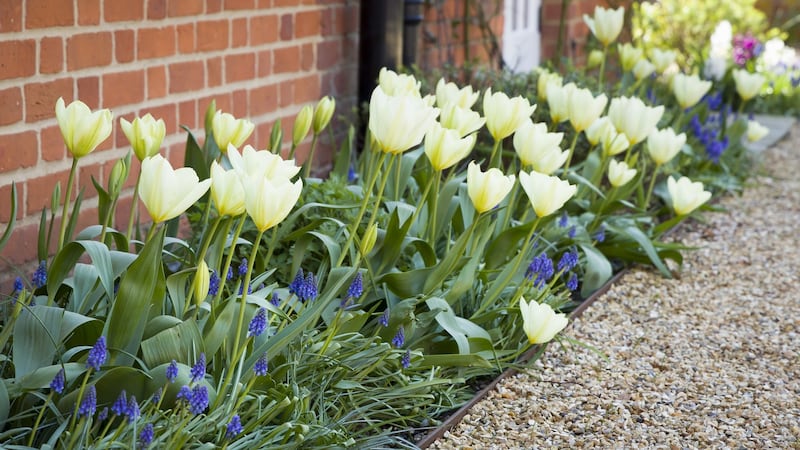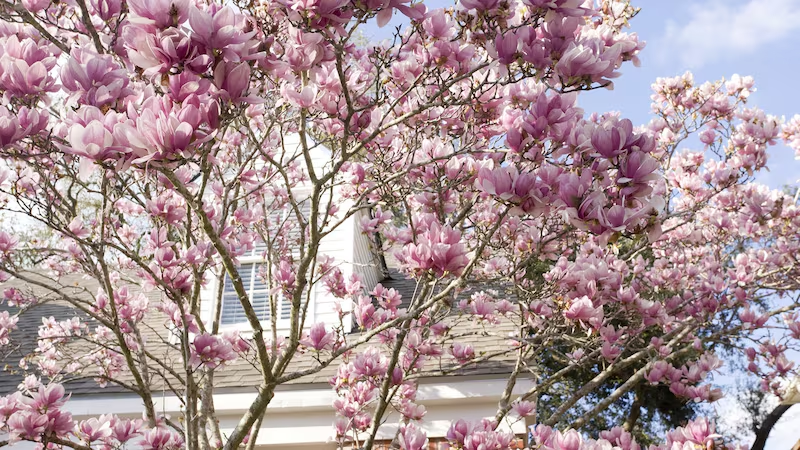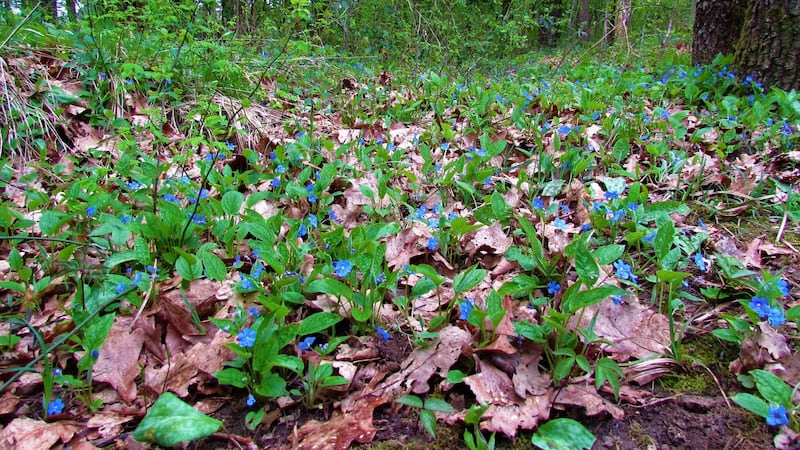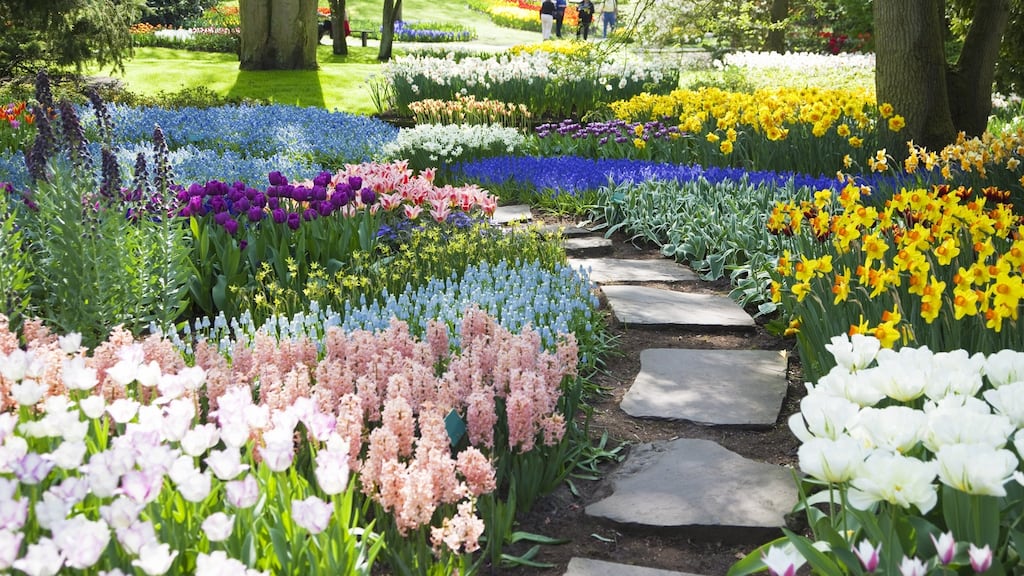Who doesn’t love April in the garden? It’s all fluff and flounce, blossom and buds, baby seedlings and succulent new growth. It’s also that time of year when herbaceous perennials emerge from their winter hibernation below ground to burst into leaf – a reminder that nature’s cycle of life continues no matter what our woes.
Indeed, some of these hardy herbaceous perennials not only burst into leaf but into bloom at this time of year, trumpeting the end of winter and the arrival of spring proper. Typically woodland species, these plants are beautiful, early-flowering opportunists that are genetically hardwired to take full advantage of the brief window of growth afforded by nature before the emerging leafy canopy of deciduous woody plants starts to quickly obscure available sunlight and to suck up ground moisture. They also provide the perfect foil for spring-flowering bulbs including varieties/species of narcissus, tulip, muscari, anemone, fritillaria, scilla, hyacinth, erythronium and leucojum, together performing the sort of horticultural tango that leaves us in no doubt as to who’s the real mastermind behind any garden.
Generally happiest in a lightly shaded, sheltered spot and a fertile, moist but free-draining soil, these herbaceous woodlanders also associate beautifully with a variety of spring-flowering trees, shrubs, semi-evergreen perennials and ferns. Examples include flowering cherries, magnolia, camellia, rhododendron, pieris, forsythia, ribes, osmanthus, viburnum, hellebores, euphorbia, bergenia, vinca, dryopteris and polystichum.

One of my all-time favourites is navelwort (Omphaloides cappadocica), the dainty perennial whose clusters of tiny, starry, kingfisher-blue flowers appear from March-June. All varieties of navelwort are drop-dead gorgeous but for something extra special, seek out the award-winning Irish cultivar known as Omphaloides “Starry Eyes” (available from the specialist nursery ballyrobertgardens.com), whose blue flowers are neatly edged with white. This hardy, fast-growing, clump-forming herbaceous perennial prefers a cool, humus-rich, moisture-retentive soil so for best results work some well-rotted garden manure, leaf mould or pine needles into the soil at planting time to encourage healthy growth.
Blue-flowering herbaceous perennials are surprisingly rare in nature, but navelwort is just on one of several very beautiful species that bloom at this time of year. Another is lungwort, the clump-forming, spring flowering perennial whose mottled, speckled leaves were once believed to be a sign that the plant possessed certain healing properties useful to those suffering from lung disease. One of the loveliest for the garden is the green-leaved, blue-flowered variety known as Pulmonaria “Blue Ensign”, which will also tolerate a sunny spot so long as the soil doesn’t ever totally dry out.
Some other varieties of pulmonaria are semi-evergreen rather than truly herbaceous, meaning they don’t ever completely die back down to below ground level each autumn. Examples include the lovely pale-blue flowering Pulmonaria “Opal”, which also flowers from March-May and the classic, white-flowered form known as Brunnera “Sissinghurst White”. All need a rich, cool, fertile oil soil and associate very well with the crisp spring freshness of foliage plants such as ferns, hostas and ornamental grasses.
If you can offer it a rich, fertile, moisture-retentive soil and a cool, sheltered spot out of the way of harsh winds and intense sunshine, then another blue-flowering, spring blooming perennial worthy of a space in any Irish garden is the dainty corydalis. Given ideal growing conditions it will continue to flower right through until late summer but generally goes into summer dormancy in June as temperatures rise and soils dry out. Corydalis flexuosa “China Blue” is probably the best-known and most widely available variety but garden-worthy new introductions include the hybrid known as Corydalis “Craigthon Blue” and the paler-flowered Corydalis “Porcelain Blue” (both are available from Dublin-based mountvenusnursery.com).

Sometimes known as Siberian bugloss, brunnera is another of my favourite spring-flowering herbaceous perennials. Daintily pretty, this, shade-tolerant species is known for its sprays of forget-me-not like blue flowers and large, handsome, heart-shaped leaves that associate so beautifully with other spring-flowering plants. The species type (Brunnera macrophylla) aside, several named varieties are also noted for their decorative, silver-green foliage including Brunnera “Jack Frost”, Brunnera “Silver Heart” and the impressively large-leaved Brunnera “Alexander’s Great”, all of which make wonderfully ornamental groundcover plants that are very useful for lighting up the edges of a shady border.
Alternatively, Brunnera “Hadspen Cream” has mottled gold-and-green foliage and blue flowers while there are also some very lovely white-flowering forms including the silver-leaved “Mr Morse”. All need a cool, permanently damp but free-draining soil and a sheltered spot in dappled shade to do well.
So does the plant commonly known as bleeding heart, one of the loveliest of all spring-flowering herbaceous perennials and often seen growing in traditional cottage gardens. Formerly called Dicentra spectabilis until taxonomists decided to give it the very unlovely name of Lamprocapnos spectabilis, its tall, arching stems are covered with dangling, heart-shaped, electric -pink flowers in April-May. If that sounds just a bit too much, then you’ll love the elegant, white-flowered form known as Lamprocapnos spectabilis “Alba”. Both will also grow in full sun so long as they’re given a cool, humus-rich, permanently damp but free-draining soil.

Meanwhile, for an area in dry shade – that trickiest of tricky planting challenges – spring-flowering epimediums are just the thing, slowly forming a dense, low carpet of groundcover. Examples include the April-May blooming Epimedium x youngianum “Niveum”, whose heart-shaped, delicate-looking leaves and soft froth of tiny white blooms bely its steely resilience. The same goes for the yellow-flowered Epimedium “Amber Queen” and the pink-and-yellow flowering Epimedium x rubrum, all of which are a great choice for planting around the base of deciduous trees.
Last, but certainly not least, are the different species of primula that come into their own in the April garden when their pretty, pollinator-friendly, sweetly-scented flowers are always a joy to behold. Examples include the drumstick primula (Primula denticulata), cowslip (Primula veris), oxslip (Primula elatior) and wild primrose (Primula vulgaris). Not all of these are true herbaceous perennials but in colder gardens they behave as such, often dying back down to ground level in winter before re-emerging in spring to mark the beginning of another growing year.
This Week in the Garden
Just one late harsh frost can badly damage the blossom of fruit bushes and fruit trees at this time of year, resulting in zero crops later in the year. So if and where possible, protect vulnerable plants by throwing a few sheets of horticultural fleece over them the evening before a hard frost is forecast. Make sure to remove it the following morning to allow pollinating insects to visit the individual flowers as without pollination, there will be no fruit.
If you didn’t get a chance to plant them last autumn, then early April is a good time of the year to plant strawberries, either as pot-grown plants or bare-root runners. Strawberries like a weed-free, fertile, moisture-retentive but free-draining soil in full sun so prepare the ground well by digging it over and adding some well-rotted garden manure or home-made compost and a few handfuls of slow-release organic fertiliser. To encourage good root establishment, water well immediately after planting. Recommended varieties include “Gariguette” (early season), “Cambridge Favourite” (mid-season) and “Symphony” (late season).
Dates for your Diary
From tomorrow until the end of April: “A Month of Tulips”, a celebration of one of the loveliest of spring-flowering bulbs at June Blake’s Garden, Tinode, Blessington, Co Wicklow, see juneblake.ie
This month: The Irish Hospice Foundation launches its 2022 Pledge to Plant Initiative, which invites Irish gardeners to propagate some plants to sell to their families and friends as a way of raising vital funds for services supporting those facing end-of-life and bereavement. To find out more and/or to register for your free supporter pack, visit hospicefoundation.ie/pledgetoplant























